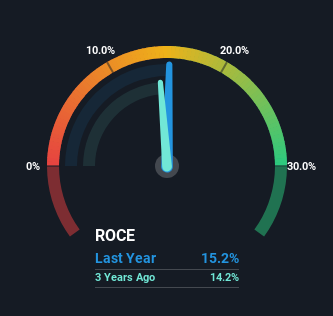Electronic Arts (NASDAQ:EA) Will Be Hoping To Turn Its Returns On Capital Around
To find a multi-bagger stock, what are the underlying trends we should look for in a business? Firstly, we'd want to identify a growing return on capital employed (ROCE) and then alongside that, an ever-increasing base of capital employed. If you see this, it typically means it's a company with a great business model and plenty of profitable reinvestment opportunities. However, after investigating Electronic Arts (NASDAQ:EA), we don't think it's current trends fit the mold of a multi-bagger.
Return On Capital Employed (ROCE): What Is It?
If you haven't worked with ROCE before, it measures the 'return' (pre-tax profit) a company generates from capital employed in its business. The formula for this calculation on Electronic Arts is:
Return on Capital Employed = Earnings Before Interest and Tax (EBIT) ÷ (Total Assets - Current Liabilities)
0.15 = US$1.6b ÷ (US$14b - US$3.3b) (Based on the trailing twelve months to December 2023).
So, Electronic Arts has an ROCE of 15%. In absolute terms, that's a satisfactory return, but compared to the Entertainment industry average of 11% it's much better.
View our latest analysis for Electronic Arts
Above you can see how the current ROCE for Electronic Arts compares to its prior returns on capital, but there's only so much you can tell from the past. If you'd like to see what analysts are forecasting going forward, you should check out our free analyst report for Electronic Arts .
How Are Returns Trending?
Unfortunately, the trend isn't great with ROCE falling from 23% five years ago, while capital employed has grown 53%. That being said, Electronic Arts raised some capital prior to their latest results being released, so that could partly explain the increase in capital employed. Electronic Arts probably hasn't received a full year of earnings yet from the new funds it raised, so these figures should be taken with a grain of salt. Also, we found that by looking at the company's latest EBIT, the figure is within 10% of the previous year's EBIT so you can basically assign the ROCE drop primarily to that capital raise.
The Key Takeaway
Bringing it all together, while we're somewhat encouraged by Electronic Arts' reinvestment in its own business, we're aware that returns are shrinking. Although the market must be expecting these trends to improve because the stock has gained 43% over the last five years. However, unless these underlying trends turn more positive, we wouldn't get our hopes up too high.
Electronic Arts could be trading at an attractive price in other respects, so you might find our free intrinsic value estimation for EA on our platform quite valuable.
If you want to search for solid companies with great earnings, check out this free list of companies with good balance sheets and impressive returns on equity.
Have feedback on this article? Concerned about the content? Get in touch with us directly. Alternatively, email editorial-team (at) simplywallst.com.
This article by Simply Wall St is general in nature. We provide commentary based on historical data and analyst forecasts only using an unbiased methodology and our articles are not intended to be financial advice. It does not constitute a recommendation to buy or sell any stock, and does not take account of your objectives, or your financial situation. We aim to bring you long-term focused analysis driven by fundamental data. Note that our analysis may not factor in the latest price-sensitive company announcements or qualitative material. Simply Wall St has no position in any stocks mentioned.

 Yahoo Finance
Yahoo Finance 
